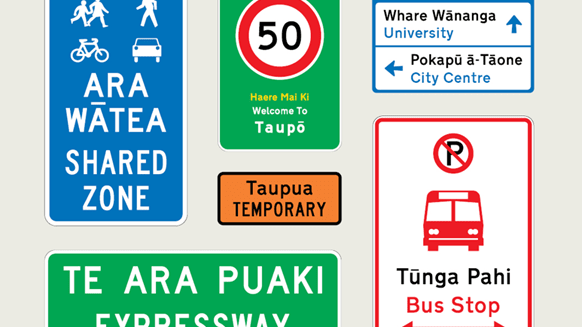Next set of bilingual signs released for public consultation

A new package of proposed bilingual traffic signs has been released for consultation.
The consultation is part of the He Tohu Huarahi Māori bilingual traffic signs programme led by Te Mātāwai and Waka Kotahi to enable the use of te reo Māori on traffic signs across Aotearoa New Zealand.
Te Mātāwai is the independent entity that works on behalf of Iwi and Māori for the revitalisation of te reo Māori. Driving this programme is a vision to see te reo Māori restored as the first language of Aotearoa New Zealand, by ensuring that te reo Māori is seen in everyday environments and heard and spoken more often.
“Using te reo Māori on traffic signs will contribute to an Aotearoa New Zealand where: te reo Māori is visible at a community level where our whānau live and play, and the mana of te reo is affirmed and recognised. Affirming the status of te reo and enabling community engagement are critical drivers of language revitalisation so we celebrate this moment,” said Te Mātāwai board co-chair Reikura Kahi.
“Bilingual signage is an important step towards affirming the indigenous status of te reo Māori in Aotearoa. Increasing awareness and access to te reo Māori in our communities and cities is also a launchpad from which new iwi language initiatives targeting new generations can grow together.”
The proposals cover 94 signs and are grouped by type, including destinations, transport, walking and cycling, advisory and warning signs, motorway and expressway advisories, and temporary warning signs.
Waka Kotahi is also proposing several changes to the Traffic Control Devices Rule, which it said are considered minor.
A panel of te reo Māori experts, Te Pae Whakamāori, was established to consider and propose translations for the package of signs.
Professor Tom Roa from Te Pae Whakamāori says seeing and hearing te reo Māori has become a norm in Aotearoa New Zealand and these translations address that visibility in the signs on our roads.
“Te Pae Whakamāori have upheld the mana of the language with an attention to a consistency of terminology across the country, but more, the safety of the community in reading, understanding, and following the signage was a priority.”
The translations also went through a moderation process, supported by Te Mātāwai.
Nicholas Manukau, Tumuaki National Manager Māori Waka Kotahi acknowledges the language as a living taonga for all New Zealanders regardless of one’s background, ‘it is a part of who we are, and what it is to be a Kiwi.’
This consultation follows the successful rule change last year to enable bilingual Kura School traffic signs.
The rollout of this package will begin with signs that need to be replaced, particularly in hard-hit regions where signs were damaged during Cyclone Gabrielle and new signs are needed.
This also reflects our low-cost implementation approach for bilingual signs, which will be introduced as existing signs are replaced or new signs are needed on the network. This is the same approach adopted for the suite of Kura School signs.
Consultation on the proposed package of bilingual traffic signs closes at 5pm, Friday 30 June 2023.





